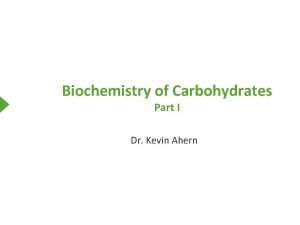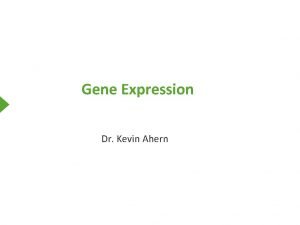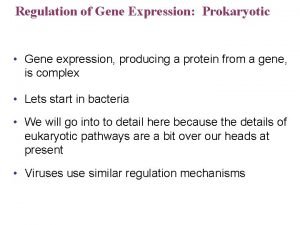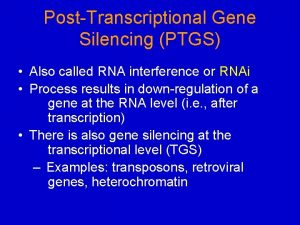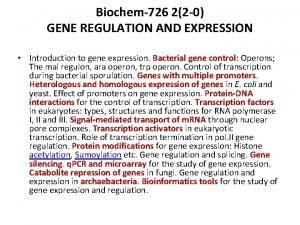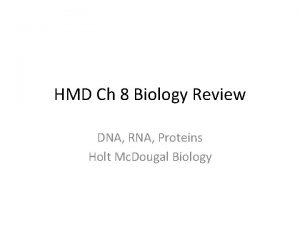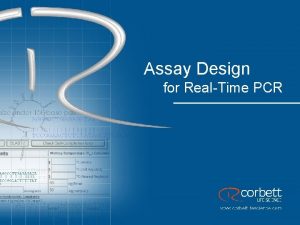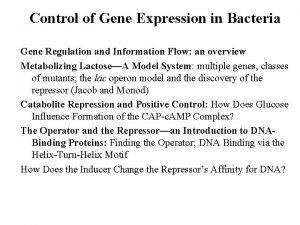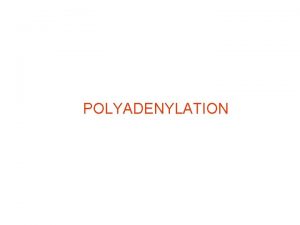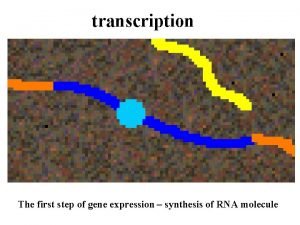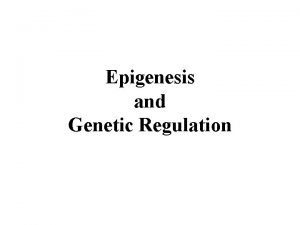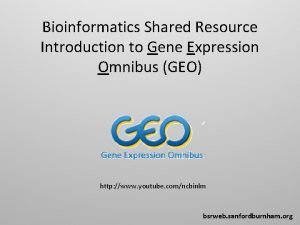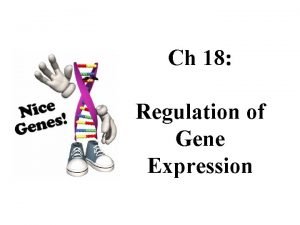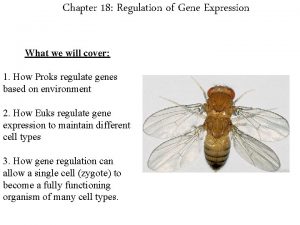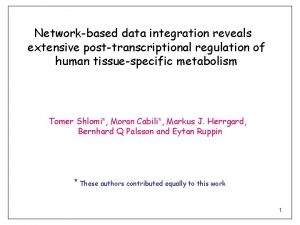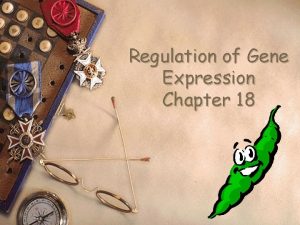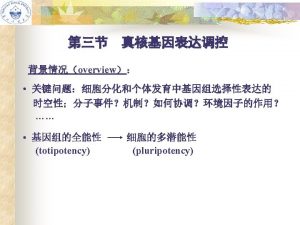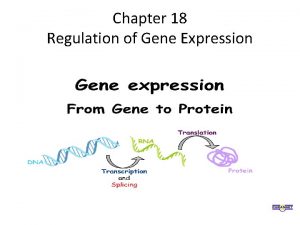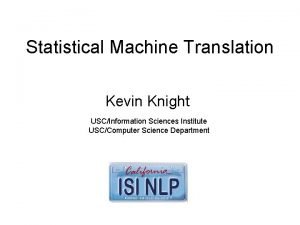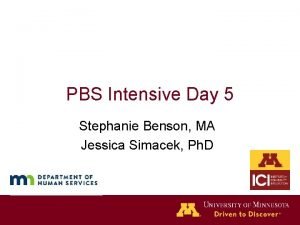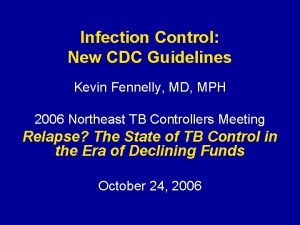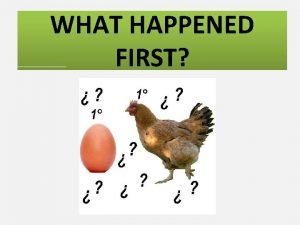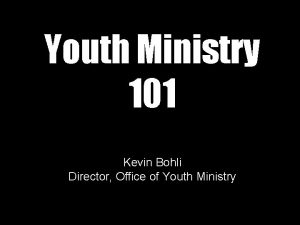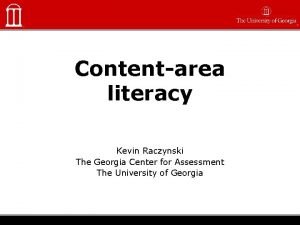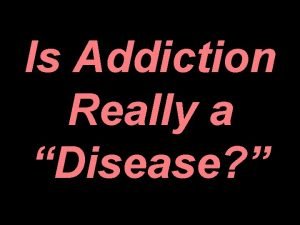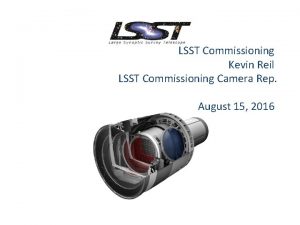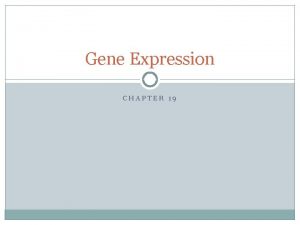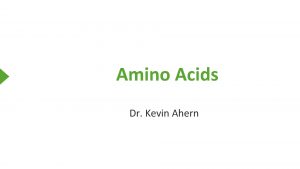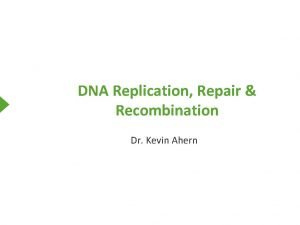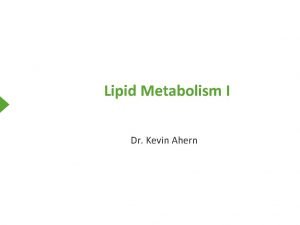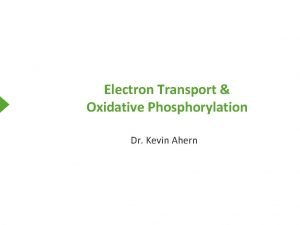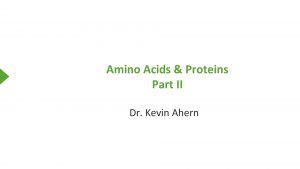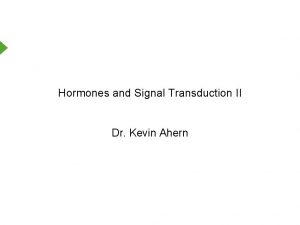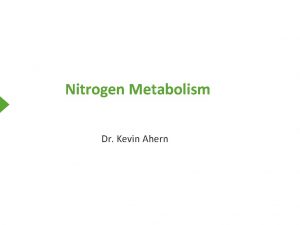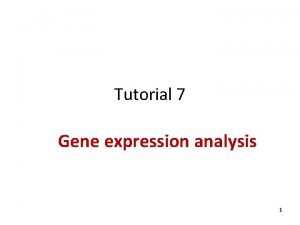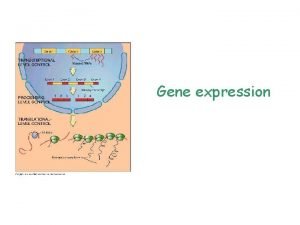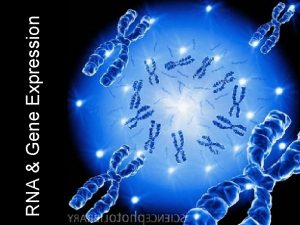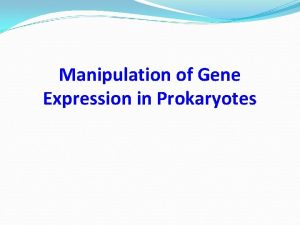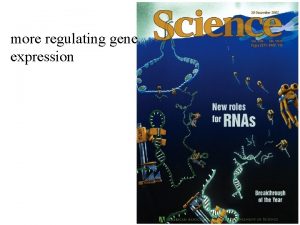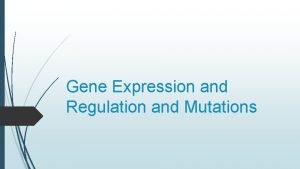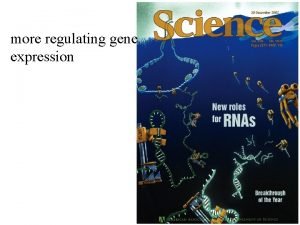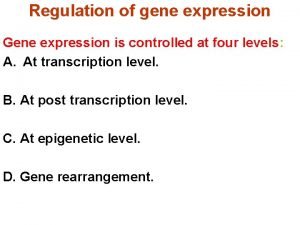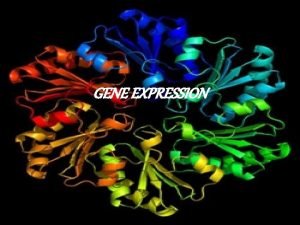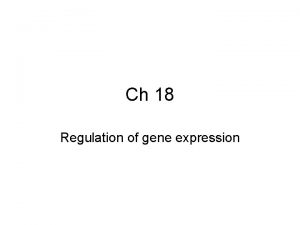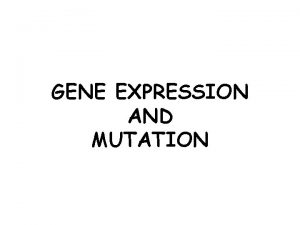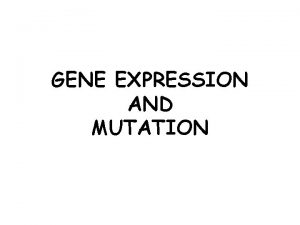Gene Expression Dr Kevin Ahern Gene Expression Gene









































- Slides: 41

Gene Expression Dr. Kevin Ahern

Gene Expression

Gene Expression Controls on Protein Levels Transcription Splicing Polyadenylation m. RNA Stability Translation Protein Stability

Transcription Control - Prokaryotic Promoter

Transcription Control - Prokaryotic Promoter Polycistronic Message in Prokaryotes

Transcription Control - Prokaryotic Promoter Allo-Lactose

Transcription Control - Prokaryotic Promoter

Transcription Control - Prokaryotic Promoter

Transcription Control - Prokaryotic Promoter CAP c. AMP CAP Site of DNA

Transcription Control - Prokaryotic Promoter From Wikimedia Commons

Prokaryotic Transcription Control - Termination/Attenuation From Wikimedia Commons

Prokaryotic Transcription Control - Termination/Attenuation

Transcription/Translation Control - Riboswitches Cis-acting sequences Anti-terminator Terminator

Transcription/Translation Control - Riboswitches Lysine Bound to Riboswitch

Eukaryotic Gene Expression • Much More Complexity • Chromatin • Many Transcription Factors • Enhancers

Transcriptional Control - Eukaryotes

RNA • Eukaryotic Gene Expression - Chromatin is the Complex of DNA, Protein, and RNA Comprising Eukaryotic Chromosomes For RNA Polymerase to Perform Transcription, Access Must Be Gained to the DNA Increasing Magnification

RNA • Eukaryotic Gene Expression - Epigenetics

RNA • Eukaryotic Gene Expression - Chromatin A Nucleosome is a Fundamental Unit of Chromatin Structure Contains Two Copies Each of Four Histone Proteins - H 2 a, H 2 B, H 3, and H 4 DNA is Wrapped Around this Octet Core and Histone H 1 is on the Outside

RNA • Eukaryotic Gene Expression - Chromatin Histone Proteins Are Rich in Basic Amino Acids, Making Them Positively Charged The Positively Charged Proteins Are Attracted Strongly to the Negatively Charged Phosphates of the DNA Chemical Modifications That Affect These Charges Influence Transcription

RNA • Eukaryotic Gene Expression - Chromatin

RNA • Eukaryotic Gene Expression - Chromatin • Histone Acetyl Transferases (HATs) Use Acetyl-Co. A to Put Acetyl Groups on Lysines in Histones • This Neutralizes Their Positive Charge and Loosens Interactions With the Histones, Facilitating “R • Acetylated Lysines Can Also be Binding Targets for Proteins Affecting Transcription n l a c i em atio c i f i od M Ch Unwinding of Complex

RNA • Eukaryotic Gene Expression - Epigenetics

RNA • Eukaryotic Gene Expression - Chromatin • Histone Acetylation Favors Euchromatin and Stimulates Transcription • Histone De-Acetylases Reverse These Effects, Favoring Heterochromatin and Gene Silencing • The Sirtuin 1 deacetylase in humans down-regulated with insulin resistance • Numerous Chemical Modifications are Made to Histone Proteins • Acetylation / Deacetylation • Methylation / Demethylation • Phosphorylation / Dephosphorylation • Ubiquitination • Chemical Modification to Bases in DNA Can Also Affect Transcription Open and Accessible to Transcription Complex Condensed and Not Accessible

RNA • Eukaryotic Gene Expression - Epigenetics

Epigenetics • Chemical Modifications in Histones and DNA Can Cross Generational Barriers • Transcriptional Effects Can Thus Be Transmitted From Parent to Progeny Independent of the Sequence of the DNA. • Such Influences are Called Epigenetic


Transcriptional Control - Eukaryotes Methylation of Cp. G sequences in eukaryotes inhibits transcription

Transcriptional Control - Eukaryotes


Transcriptional Control - Eukaryotes

RNA • Eukaryotic Gene Expression - Transcription Blocking Insulators Allows Enhancer to Activate Transcription Insulators Can Block Enhancer’s Activation of Transcription

Iron Transfer & Storage Ferritin - Cellular Protein to Bind Iron Transferrin Receptor - Membrane Protein to Transfer Iron

Iron Transfer & Storage Iron Response Element (IRE) Iron Response Element Binding Protein (IRE-BP)

Iron Transfer & Storage - Translation Regulation

Iron Transfer & Storage - m. RNA Stability

RNA • RNA Interference is a Powerful Means of Controlling Gene Expression • Viral and Endogenous Cellular Genes Are Targets • A Similar System Called pi. RNA (piwi RNA) Protects Against Transposon Genes • Considerable Interest in Using Technique to Genetically Transform Organisms for Protect Against Pathogens

Cellular Source RNA Cellular Pre-Processing • RNA Interference Transcription Double-Stranded RNA is Stimulus Processing Viral Infection 20 bp pieces RISC Target Complementary Sequences in m. RNAs

RNA • RNA Interference Complementary Sequences Align RISC + Argonaute Activity in RISC Breaks m. RNA, Stops Translation m. RNA Translation of m. RNA Stopped + RISC

RNA • RNA Interference • • • Protection Against Invading Viruses Stimulated by ds. RNA mi. RNA (cellular) & si. RNA (foreign) Cellular piwi RNAs (pi. RNA) have similar functions in silencing transposons Widespread in Eukaryotes Actions referred to as RNA Interference (RNAi) RNA Interference Operates Through the Silencing of Gene Expression DS RNA induces Dicer to chop it into 20 BP Pieces These si. RNAs/mi. RNAs bind to the RNA Induced Silencing Complex (RISC) One Strand is Destroyed and One Retained to Bind to Complementary m. RNA sequences • RISC Nuclease Activity (Argonaute) • 1. Destroys m. RNA Where Strand Binds or • 2. si. RNA/mi. RNA strand on m. RNA blocks translation or • 3. si/RNA/mi. RNA strand destabilizes m. RNA and Targets for Destruction

RNA • RNA Interference Bonding to m. RNA Premature Stopping of Translation Degradation of m. RNA
 Kevin ahern biochemistry
Kevin ahern biochemistry Gene expression:
Gene expression: Ahern tractors
Ahern tractors Chapter 17 from gene to protein
Chapter 17 from gene to protein Gene by gene test results
Gene by gene test results Gene expression in prokaryotes and eukaryotes
Gene expression in prokaryotes and eukaryotes Genetic effects on gene expression across human tissues
Genetic effects on gene expression across human tissues Prokaryotic gene expression
Prokaryotic gene expression Gene expression
Gene expression Regulation of gene expression
Regulation of gene expression Cells must control gene expression so that __________.
Cells must control gene expression so that __________. Taqman gene expression assay
Taqman gene expression assay Lac operon positive or negative control
Lac operon positive or negative control Regulation of gene expression in bacteria
Regulation of gene expression in bacteria Gene expression
Gene expression טרנסלציה
טרנסלציה Lyonization of gene expression
Lyonization of gene expression Gene expression omnibus tutorial
Gene expression omnibus tutorial Ch 18
Ch 18 Chapter 18 regulation of gene expression
Chapter 18 regulation of gene expression Gene expression
Gene expression Chapter 18 regulation of gene expression
Chapter 18 regulation of gene expression Gene expression
Gene expression Chapter 18 regulation of gene expression
Chapter 18 regulation of gene expression Quadratic expression
Quadratic expression Kevin theissen
Kevin theissen Kevin knight usc
Kevin knight usc Site:slidetodoc.com
Site:slidetodoc.com Kevin benson md
Kevin benson md Kevin fennelly
Kevin fennelly Kevin (go) home by the time i arrived
Kevin (go) home by the time i arrived Kevin bohli
Kevin bohli Majority decision making
Majority decision making Kevin himpe
Kevin himpe Kevin brunner
Kevin brunner Kevin raczynski
Kevin raczynski Hedonic set point
Hedonic set point Kevin nasg
Kevin nasg John yelenic
John yelenic Kevin demott
Kevin demott Part of camera
Part of camera Kevin skadron
Kevin skadron
